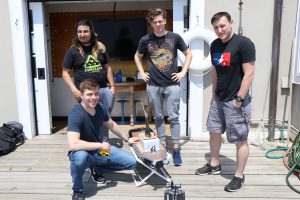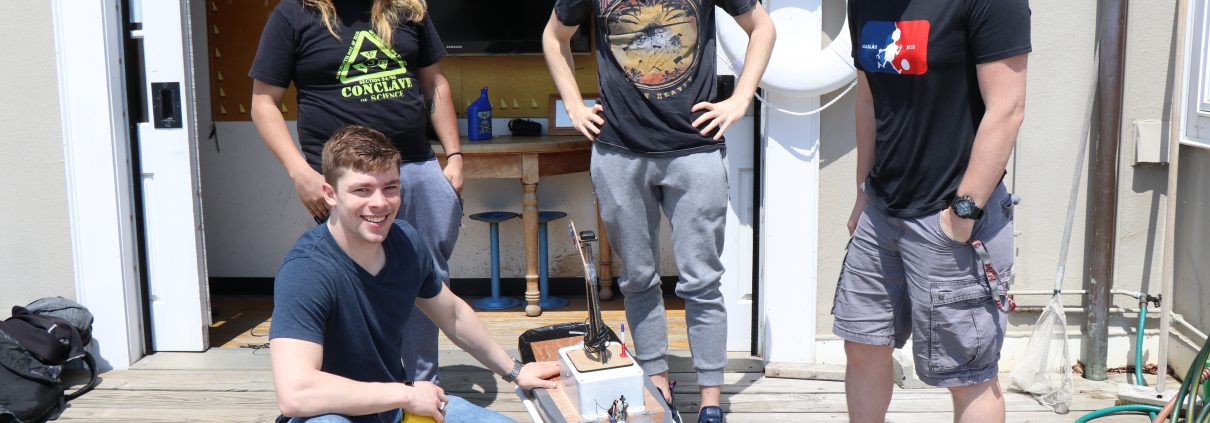Undergraduate students join MIT Sea Grant for hands on summer research
 MIT Sea Grant’s teaching lab was bustling this summer with more than 10 undergraduate students, and a handful of exceptional high school students all working on projects that varied from mapping eelgrass using drones to building ocean drifters and modifying ocean engineering teaching tools. Students attended weekly lunches to discuss their work and learn how their work can help others in the lab creating a welcoming, integrated and exciting learning environment. NOAA Hollings Scholar Scott Nesbit used unmanned aerial systems, better known as drones, to map eelgrass beds along the Massachusetts coast. Drone technology reduces cost, time, and effort when it comes to mapping eelgrass. Nesbit developed strategies and method protocols during his time with MIT Sea Grant, enabling researchers to take advantage of opportunities that UAS have to offer.MIT UROP student Noa Yoder interned with the MIT Sea Grant AUV lab. Yoder focused most of her efforts this summer on a smart buoy, equipping it with sensors that measure water quality and weather. The buoy will house a Eureka Sonde water probe, which measures pH, chlorophyll, dissolved oxygen, and salinity from surrounding waters, giving researchers an unique insight into coastal characteristics.MIT UROP student Rachel O’Grady spent her summer designing and building an ocean drifter. O’Grady added three sensors to the drifter¡s design to measure salinity, pH, and temperature. These sensors are alongside an onboard GPS, to record the precise location of each data point.MIT UROP student Jocelyn Lorrey worked with Dr. Thomas Consi, an education specialist at MIT Sea Grant. Her research focused on improving the SeaPerch, an ocean engineering teaching tool, used in classrooms all around the world. Lorry’s work will lay the foundation for making the SeaPerch fully autonomous.MIT UROP student Michelle Kornberg helped run MIT’s E2@MIT ocean engineering experience where she mentored 12 exceptional high school students for their 10 day long stay on MIT’s campus.NOAA Hollings Scholars Caleb Perez and Tzofi Klinghoffer worked with researchers at MIT Sea Grant, focusing on developing technological solutions that will improve upon current methods used for monitoring fish populations.MIT SeaGrant and MIT Space Grant’s first join student, Matt Mullin spent his summer conducting coastal erosion research using drone technology. His fieldwork and resulting analysis will hopefully improve the accuracy of coastal erosion mapping done by drones.If you are a student interested in doing research with MIT SeaGrant please contact our research education specialist Dr. Thomas Consi at consi@mit.edu.
MIT Sea Grant’s teaching lab was bustling this summer with more than 10 undergraduate students, and a handful of exceptional high school students all working on projects that varied from mapping eelgrass using drones to building ocean drifters and modifying ocean engineering teaching tools. Students attended weekly lunches to discuss their work and learn how their work can help others in the lab creating a welcoming, integrated and exciting learning environment. NOAA Hollings Scholar Scott Nesbit used unmanned aerial systems, better known as drones, to map eelgrass beds along the Massachusetts coast. Drone technology reduces cost, time, and effort when it comes to mapping eelgrass. Nesbit developed strategies and method protocols during his time with MIT Sea Grant, enabling researchers to take advantage of opportunities that UAS have to offer.MIT UROP student Noa Yoder interned with the MIT Sea Grant AUV lab. Yoder focused most of her efforts this summer on a smart buoy, equipping it with sensors that measure water quality and weather. The buoy will house a Eureka Sonde water probe, which measures pH, chlorophyll, dissolved oxygen, and salinity from surrounding waters, giving researchers an unique insight into coastal characteristics.MIT UROP student Rachel O’Grady spent her summer designing and building an ocean drifter. O’Grady added three sensors to the drifter¡s design to measure salinity, pH, and temperature. These sensors are alongside an onboard GPS, to record the precise location of each data point.MIT UROP student Jocelyn Lorrey worked with Dr. Thomas Consi, an education specialist at MIT Sea Grant. Her research focused on improving the SeaPerch, an ocean engineering teaching tool, used in classrooms all around the world. Lorry’s work will lay the foundation for making the SeaPerch fully autonomous.MIT UROP student Michelle Kornberg helped run MIT’s E2@MIT ocean engineering experience where she mentored 12 exceptional high school students for their 10 day long stay on MIT’s campus.NOAA Hollings Scholars Caleb Perez and Tzofi Klinghoffer worked with researchers at MIT Sea Grant, focusing on developing technological solutions that will improve upon current methods used for monitoring fish populations.MIT SeaGrant and MIT Space Grant’s first join student, Matt Mullin spent his summer conducting coastal erosion research using drone technology. His fieldwork and resulting analysis will hopefully improve the accuracy of coastal erosion mapping done by drones.If you are a student interested in doing research with MIT SeaGrant please contact our research education specialist Dr. Thomas Consi at consi@mit.edu.



Leave a Reply
Want to join the discussion?Feel free to contribute!